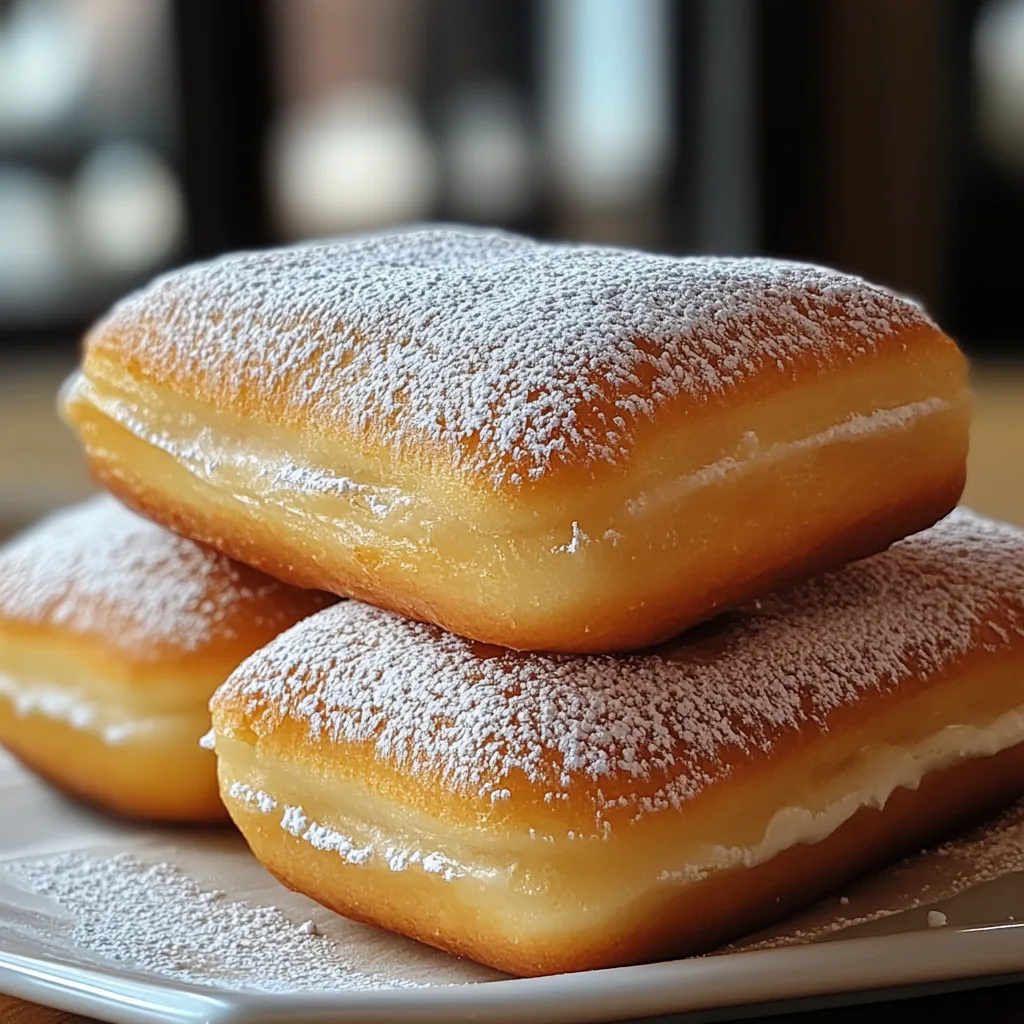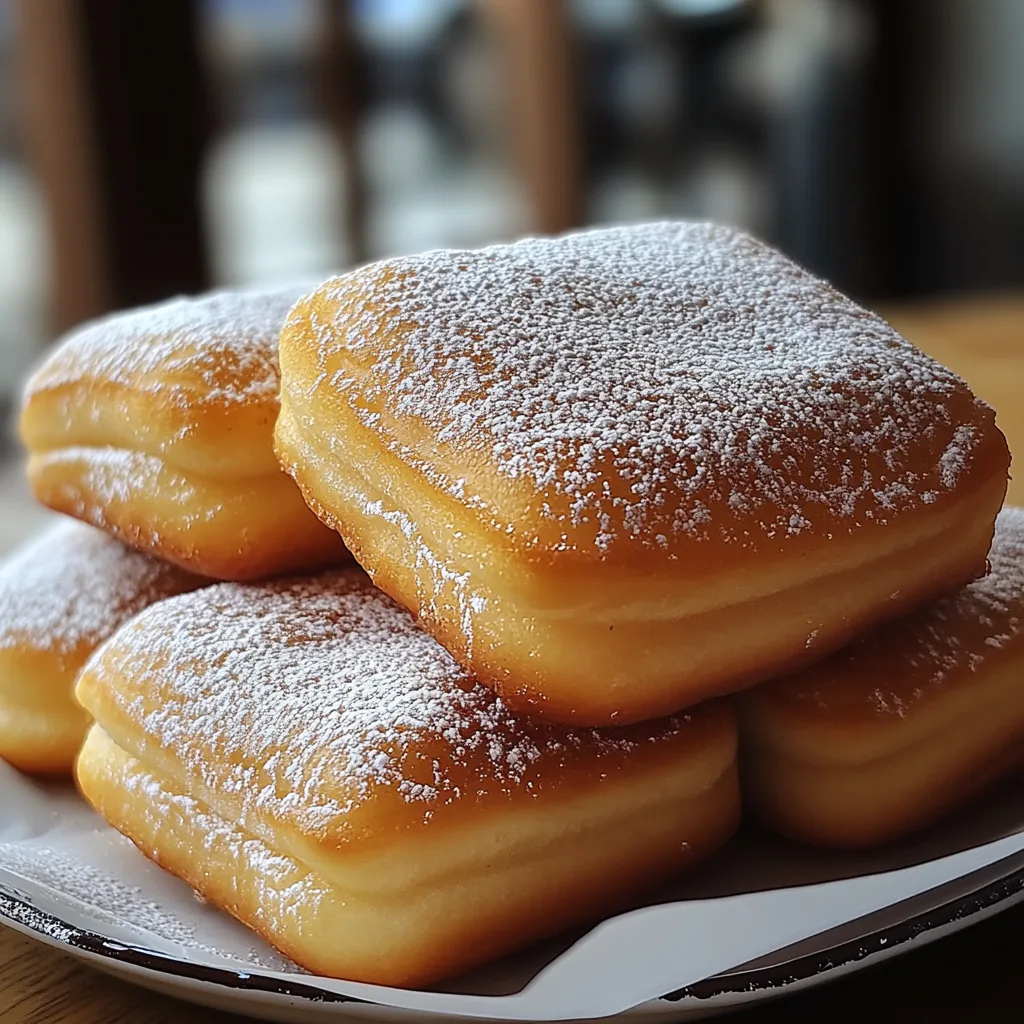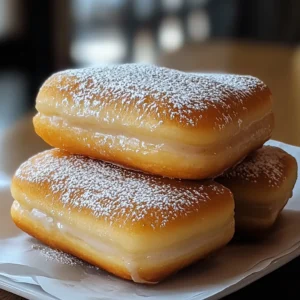The moment a batch of Vanilla French Beignets emerges from the hot oil, something magical happens in my kitchen. That first billow of sweet, vanilla-infused steam escaping from the pillowy interior as I break one open never fails to transport me straight to the cobblestone streets of New Orleans. As a chef who’s experimented with countless pastries, these Vanilla French Beignets hold a special place in my repertoire. The contrasting textures—the delicate crispness of the golden exterior giving way to an ethereally light, airy center—create an experience that’s both rustic and refined. What truly elevates these Vanilla French Beignets is the interplay between the warm dough, fragrant vanilla, and the cool, sweet snowfall of powdered sugar that clings to everything (including your smile). Keep reading to discover my foolproof technique for achieving that perfect puff every single time—a secret that took me years of testing to perfect.
Why You’ll Love These Vanilla French Beignets

If you’ve ever been intimidated by deep-frying or working with yeasted dough, these Vanilla French Beignets will change everything. The dough is remarkably forgiving, and unlike other fried pastries that demand split-second timing, these beignets give you a comfortable window of perfection.
I first mastered this recipe after a transformative trip to New Orleans, where I became obsessed with recreating that distinctive texture at home. My first attempts were disappointingly dense until a chance conversation with an elderly woman at the farmers market changed everything. “You’re handling the dough too much, cher,” she told me with a knowing smile. Following her advice to treat the dough gently resulted in the ethereal puffs I’d been chasing. When I served these Vanilla French Beignets at my sister’s bridal shower, my notoriously hard-to-impress aunt—who normally refuses desserts—asked for the recipe. That’s when I knew this version was something special.
What makes these Vanilla French Beignets truly versatile is how easily they transform with different accompaniments. Serve them traditionally with café au lait for breakfast, alongside fresh berries for brunch, or with chocolate dipping sauce for dessert. The subtle vanilla foundation makes them perfect for any seasonal adaptation—citrus zest in winter, lavender in spring, or bourbon in fall.
Now, let’s dive into what makes these Vanilla French Beignets truly exceptional, from ingredients to technique.
Ingredients for Vanilla French Beignets
For the Dough:
- 2¼ teaspoons active dry yeast (1 standard packet): The leavening agent that creates those magical air pockets. For best results, use fresh yeast—check the expiration date! In a pinch, instant yeast works too, just reduce the amount to 1¾ teaspoons.
- ¾ cup warm water (110°F): Temperature is crucial here—too hot will kill the yeast, too cool won’t activate it. Use a kitchen thermometer for precision.
- ¼ cup granulated sugar: Provides sweetness and food for the yeast. Organic cane sugar adds a subtle complexity, but standard granulated works perfectly.
- ½ teaspoon salt: Balances the sweetness and enhances the vanilla flavor. I prefer fine sea salt for its clean taste.
- 1 large egg, beaten: Provides richness and structure to the dough. Room temperature eggs incorporate more easily.
- ½ cup evaporated milk: My secret ingredient for tender beignets with a subtle richness that regular milk can’t match. Not to be confused with sweetened condensed milk!
- 2 tablespoons unsalted butter, melted: Adds richness and helps create that melt-in-your-mouth texture. European-style butter with higher fat content elevates these Vanilla French Beignets further.
- 1½ tablespoons pure vanilla extract: The star flavor! Use real vanilla extract, not imitation. For an incredible upgrade, split and scrape a whole vanilla bean into the dough.
- 4 cups all-purpose flour, plus more for dusting: The foundation of our beignets. Southern brands like White Lily create exceptionally tender results, but any all-purpose flour will work.
- Vegetable oil for frying (about 2 quarts): Choose a neutral oil with a high smoke point like peanut oil, canola oil, or vegetable oil blend.
For the Topping:
- 2 cups confectioners’ sugar: The classic finishing touch. Sift it twice for the lightest, lump-free coating.
- Optional: ½ teaspoon vanilla bean powder: For enhanced vanilla presence in every bite. This is my special touch that differentiates these from standard beignets.
How to Make Vanilla French Beignets

Step 1: Activate the Yeast
- In a large bowl, combine warm water (110°F), ¼ cup sugar, and yeast. Stir gently to dissolve.
- Let stand for 5-10 minutes until foamy. This visual cue—a creamy foam on top—confirms your yeast is alive and active.
- If the mixture doesn’t foam, your yeast may be old or your water temperature was off. Start again with fresh ingredients—this foundation is essential for perfect Vanilla French Beignets.
Step 2: Create the Dough
- Add the beaten egg, evaporated milk, melted butter (cooled slightly), vanilla extract, and salt to the yeast mixture. Whisk until smooth and fragrant—you should be able to smell the vanilla already.
- Gradually add 3 cups of flour, mixing with a wooden spoon until the dough comes together. The dough will look shaggy and somewhat sticky at this stage.
- Add the remaining cup of flour a little at a time, incorporating just enough until the dough forms a soft, slightly tacky ball that pulls away from the sides of the bowl. You might not need all the flour, or you might need a bit more—trust the feel of the dough.
- Turn the dough onto a lightly floured surface. Knead gently for just 2-3 minutes until smooth. This is much less than typical bread dough—remember, gentle handling is key for tender Vanilla French Beignets.
Step 3: First Rise
- Place the dough in a lightly oiled bowl, turning once to coat. Cover with plastic wrap or a damp kitchen towel.
- Allow to rise in a warm, draft-free area for 1-1½ hours, or until doubled in size. The perfect environment is about 75-80°F—I often turn my oven on for just 1 minute, then turn it off and use it as a proofing box.
- The dough is ready when you press it gently with your finger and the indentation remains. You’ll also notice a slightly sweet, yeasty aroma developing.
Step 4: Shape the Beignets
- Once risen, punch down the dough gently to release excess air bubbles. Turn onto a lightly floured surface.
- Roll the dough into a rectangle approximately ¼-inch thick. Don’t go thinner, or you’ll lose the signature puff of authentic Vanilla French Beignets.
- Using a sharp knife or pizza cutter, cut the dough into 2½-inch squares. Don’t worry about perfect measurements—slightly irregular shapes give these Vanilla French Beignets their rustic charm.
- Place cut dough pieces on parchment-lined baking sheets dusted with flour, leaving some space between each piece.
Step 5: Second Rise (Optional but Recommended)
- For the most authentic Vanilla French Beignets, cover the cut pieces loosely with a clean kitchen towel and let rest for 30 minutes. This short second rise creates an even lighter texture.
- During this time, prepare your frying setup and organize your workflow. Place a cooling rack over a baking sheet near your frying area for draining.
Step 6: Fry to Golden Perfection
- In a heavy-bottomed Dutch oven or deep fryer, heat 2-3 inches of oil to 360-370°F. Use a thermometer for precision—temperature is crucial for perfect Vanilla French Beignets.
- Carefully lower 3-4 beignets into the hot oil, being careful not to overcrowd the pot. They should immediately float to the surface and begin to puff.
- Fry for about 1-2 minutes per side until golden brown, using a slotted spoon or chopsticks to flip them once. The visual cue is a rich, golden-amber color—not too pale (undercooked inside) and not too dark (bitter taste).
- Remove using a slotted spoon or spider strainer, allowing excess oil to drain off briefly before transferring to the prepared cooling rack.
- Monitor your oil temperature between batches, adjusting the heat as needed to maintain 360-370°F.
Step 7: The Finishing Touch
- While still warm, generously dust the Vanilla French Beignets with sifted powdered sugar. Be extravagant here—a proper beignet should be nearly hidden under its sweet blanket.
- For my signature vanilla-enhanced version, mix the optional vanilla bean powder with the confectioners’ sugar before dusting.
- Serve immediately while still warm for the most authentic experience.
Delicious Variations for Vanilla French Beignets
Chocolate-Filled Vanilla French Beignets
Before cutting the dough, place small pieces of high-quality dark chocolate (about ½ teaspoon) in the center of each planned square. Fold the dough over to enclose completely and seal the edges well before frying. The chocolate melts into a molten center that contrasts beautifully with the crisp exterior.
Citrus-Infused Vanilla French Beignets
Add the zest of one orange or lemon to the dough when incorporating the vanilla. For the finishing touch, mix a tablespoon of citrus zest with the powdered sugar before dusting. This bright variation is perfect for summer brunches or alongside morning coffee.
Café au Lait Vanilla French Beignets
Add 1 tablespoon of espresso powder to the dough and reduce the vanilla to 1 tablespoon. After frying, dust with a mixture of powdered sugar and 1 teaspoon of finely ground coffee. Serve with a chicory coffee dip for an elevated New Orleans experience.
Bourbon Vanilla French Beignets
Replace 2 tablespoons of the evaporated milk with good quality bourbon and add ¼ teaspoon of freshly grated nutmeg to the dough. The alcohol cooks off, leaving behind complex caramel notes that complement the vanilla beautifully.
Lavender Honey Vanilla French Beignets
Add 1 teaspoon of culinary lavender (crushed with a mortar and pestle) to the dough. Replace the standard powdered sugar with a lavender-honey glaze made by mixing 1 cup powdered sugar with 2 tablespoons honey and enough warm water to create a drizzling consistency.
Pumpkin Spice Vanilla French Beignets
Add ¼ cup pumpkin puree (not pie filling) and 1 teaspoon pumpkin pie spice to the dough. You may need to add a bit more flour to compensate for the added moisture. Dust with cinnamon-sugar instead of plain powdered sugar for a fall-inspired treat.

Vanilla French Beignets
Equipment
- Large mixing bowl
Ingredients
For the Dough:
- 2¼ teaspoons active dry yeast 1 standard packet
- ¾ cup warm water 110°F
- ¼ cup granulated sugar
- ½ teaspoon salt
- 1 large egg beaten
- ½ cup evaporated milk
- 2 tablespoons unsalted butter melted
- 1½ tablespoons pure vanilla extract
- 4 cups all-purpose flour plus more for dusting
- Vegetable oil for frying about 2 quarts
For the Topping:
- 2 cups confectioners’ sugar
- Optional: ½ teaspoon vanilla bean powder for extra vanilla flavor
Instructions
- Activate the Yeast: Combine warm water, sugar, and yeast. Stir and let stand until foamy (5-10 minutes). If the mixture doesn’t foam, start over with fresh yeast.
- Create the Dough: Add the beaten egg, evaporated milk, melted butter, vanilla extract, and salt to the yeast mixture. Gradually add the flour, mixing until a soft, slightly tacky dough forms.
- First Rise: Cover the dough and let it rise in a warm place for 1-1½ hours until doubled in size.
- Shape the Beignets: Punch down the dough and roll it into a rectangle. Cut into 2½-inch squares and place on a floured baking sheet.
- Second Rise (Optional but Recommended): Let the shaped dough rest for 30 minutes.
- Fry the Beignets: Heat oil in a deep fryer or Dutch oven to 360-370°F. Fry 3-4 beignets at a time until golden brown, about 1-2 minutes per side.
- Finishing Touch: Dust the beignets generously with powdered sugar and serve warm.
Notes
- For fluffier beignets, treat the dough gently and avoid overworking it.
- If you don’t have vanilla bean powder, simply use extra vanilla extract for a strong flavor.
- Beignets are best enjoyed fresh, but they can be stored in an airtight container for up to 2 days.
Nutrition
Frequently Asked Questions About Vanilla French Beignets
Can I make the dough for Vanilla French Beignets ahead of time?
Absolutely! The dough can be made up to 24 hours ahead and refrigerated after the first rise. Punch it down gently, place in an airtight container, and refrigerate. When ready to use, allow the dough to come to room temperature for about 30 minutes before rolling and cutting. This slow, cold fermentation actually develops more complex flavors in your Vanilla French Beignets.
Why aren’t my Vanilla French Beignets puffing up properly?
The most common culprits are inactive yeast, over-kneaded dough, or oil temperature issues. Ensure your yeast is fresh and properly activated (should foam within 10 minutes). Keep kneading minimal—just until smooth. Finally, maintain oil temperature between 360-370°F; too cool and they’ll absorb oil and stay dense, too hot and they’ll brown outside before cooking inside.
Can I bake these Vanilla French Beignets instead of frying them?
While traditional Vanilla French Beignets are fried, you can bake them at 400°F for about 10-12 minutes for a lighter version. Brush with melted butter immediately after baking, then dust with powdered sugar. The texture will be more like a sweet roll than a true beignet, but still delicious.
How do I store leftover Vanilla French Beignets?
Beignets are best enjoyed fresh, but leftovers can be stored in an airtight container at room temperature for 1-2 days. To refresh, warm them in a 300°F oven for 5 minutes, then dust with fresh powdered sugar. For longer storage, freeze undusted beignets for up to 1 month, then reheat from frozen in a 350°F oven for 5-8 minutes.
Can I make Vanilla French Beignets without dairy?
Yes! Replace the evaporated milk with coconut cream or full-fat oat milk, and use plant-based butter. The texture will be slightly different but still delicious. For the egg, a commercial egg replacer works best in this recipe, as it helps maintain the structure needed for proper rising.
My kitchen gets messy with all the powdered sugar! Any tips?
The sugar shower is part of the authentic experience, but to minimize mess, try dusting the Vanilla French Beignets inside a paper bag: place 2-3 warm beignets in a paper bag with ¼ cup powdered sugar, fold the top, and shake gently. They’ll be perfectly coated with less sugar drifting around your kitchen. Alternatively, serve them on a plate that has been pre-dusted with powdered sugar.
A Sweet Connection to Tradition
I’ll never forget serving these Vanilla French Beignets at my daughter’s graduation brunch. My French grandmother, who rarely offered culinary compliments, took one bite and closed her eyes momentarily. “C’est comme à la maison,” she whispered—it’s like home. In that moment, these pillowy pastries became more than just a recipe; they became a bridge between generations, between New Orleans and her childhood in southern France.
There’s something profoundly connecting about foods that have traveled through time and across oceans, adapting slightly to new ingredients and preferences while maintaining their soul. These Vanilla French Beignets honor that tradition while offering the gentle innovation of enhanced vanilla flavor—a respectful nod to both preservation and evolution.
As you dust your kitchen (and likely yourself) with powdered sugar and bite into that first warm, pillowy Vanilla French Beignet, I hope you feel that same connection—to New Orleans, to French culinary tradition, and to the simple joy of transforming humble ingredients into something momentarily transcendent. Make them your own—perhaps with one of the variations I’ve suggested, or with your own inspired twist.
In the end, the true magic of Vanilla French Beignets isn’t just in their perfect texture or delicate sweetness—it’s in the way they gather people around the table, creating new memories amidst the powdered sugar chaos. And isn’t that the most delicious tradition of all?
